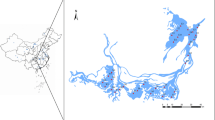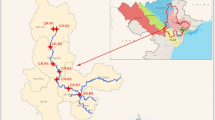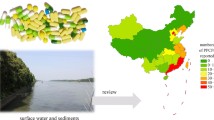Abstract
The concentrations and distribution patterns of three typical pharmaceuticals and personal care products (PPCPs) in water and sediment samples obtained from Danjiangkou Reservoir during two seasonal sampling periods were studied to determine their impact on water quality. The temporal and spatial variations in concentrations measured were analyzed and related to ecological risks with data obtained during the mean-flow period (in June) and the dry period (in November). We found a high detection rate of ketoprofen (KTP) in water samples from Danjiangkou Reservoir; the concentrations ranged from not detected (ND) to 46.80 ng/L with the highest values measured in the Hanku tributary samples followed by the samples collected in the main body of Danjiangkou Reservoir. The KTP concentrations in the Danku tributary samples were the lowest measured in this study. In addition, the concentrations of KTP in the Shending River, Sihe River, Jianghe River, Guanshan River, and Jianhe River water samples were relatively high in the mean-flow period. The water sample detection rates and concentrations of triclosan (TCS) and triclocarban (TCC) were low in both the mean-flow period and the dry period. All three kinds of PPCPs were detected in the sediment samples with the concentrations of KTP, TCS, and TCC ranging from 0.76 to 7.89 μg/kg, 0.01 to 0.59 μg/kg, and 0.01 to 11.36 μg/kg, respectively. Overall, the concentrations of the three measured PPCPs in the water and sediment samples were all relatively low compared to results reported in the recent literature. The dry period concentrations of PPCPs in the water samples were lower than the concentrations measured in the mean-flow period. However, dry period concentrations were higher in the sediment samples compared to those in the mean-flow period samples. Our interpretation of the spatial and temporal patterns of PPCPs in Danjiangkou Reservoir suggests that these compounds were likely mainly derived from wastewater discharge in the upper reaches of the reservoir. The risk quotient (RQ) method was used for an ecological risk assessment of the detected PPCPs in this study. We found that TCS in water and sediment posed medium ecological risks to algae at different times of the year. In view of the extreme importance of water safety in Danjiangkou Reservoir, the ecological risks of PPCPs require additional attention.




Similar content being viewed by others
Data availability
Due to the nature of this research, participants of this study did not agree for their data to be shared publicly, so supporting data is not available.
References
Cao S, Duan Y, Tu Y (2020) Pharmaceuticals and personal care products in a drinking water resource of Yangtze River Delta Ecology and Greenery Integration Development Demonstration Zone in China: occurrence and human health risk assessment. Sci Total Environ 721(1):137624
Chen X, Zhang C, Yang J (2020) Detection, distribution and risk assessment of typical drugs and personal care products in the waters of HuangDonghai Sea. Environ Sci 41(1):194–204 ((in Chinese))
Delorenzo ME, Keller JM, Arthur CD (2008) Toxicity of the antimicrobial compound triclosan and formation of the metabolite methyl-triclosan in estuarine systems. Environ Toxicol 23(2):224–232
Dussault EB, Balakrishnan VK, Sverko E (2008) Toxicity of human pharmaceuticals and personal care products to benthic invertebrates. Environ Toxicol Chem 27(2):425–432
Ferreira DA, Silva B, Jelic A, Lopez-Serna R (2011) Occurrence and distribution of pharmaceuticals in surface water, suspended solids and sediments of the Ebro River basin, Spain. Chemosphere 85(8):1331–1339
Gao Y, Li J, Xu N (2018) Pollution levels and ecological risks of PPCPs in water and sediment samples of Hanjiang River. Environ Chem 37(8):1706–1719 ((in Chinese), 41(10))
Gonzalez RM, Bebianno MJ (2012) Does non-steroidal anti-inflammatory(NSAID) ibuprofen induce antioxidant stress and endocrine disruption in mussel Mytilus galloprovincialis? Environ Toxicol Phamacol 33(2):361–371
Halling B, Lutzhoft H, Andersen HR (2000) Environmental risk assessment of antibiotics: comparison of mecillinam, trimethoprim and ciprofloxacin. J Antimicrob Chemother 461:53–58
Harada A, Komori K, Nakada N (2008) Biological effects of PPCPs on aquatic lives and evaluation of river waters affected by different wastewater treatment levels. Water Sci Technol 58(8):1541–1546
Jiang X, Zhu Y, Liu L (2021) Occurrence and variations of pharmaceuticals and personal-care products in rural water bodies: a case study of the Taige Canal (2018–2019). Sci Total Environ 762(1):143138
Karickhoff SW (1981) Semi-empirical estimation of sorption of hydrophobic pollutants on natural sediment & soils. Chemosphere 10(8):833–846
Kim Y, Choi K, Jung J (2007) Aquatic toxicity of acetaminophen, carbamazepine, cimetidine, diltiazem and six major sulfonamides, and their potential ecological risks in Korea. Environ Int 33(3):370–375
Kim J, Ishibashi H, Yamauchi R (2009) Acute toxicity of pharmaceutical and personal care products on freshwater crustacean (Thamnocephalus platyurus) and fish (Oryzias latipes)[J]. J Toxicol Sci 34(2):227–232
Li W, Gao L, Shi Y (2015) Occurrence, distribution and risks of antibiotics in urban surface water in Bei**g, China. Environ Sci-Process Impacts 17(9):1611–1619
Li S, Shi W, Liu W (2018) A duodecennial national synthesis of antibiotics in China’s major rivers and seas (2005–2016). Sci Total Environ 615:906–917
Li L, Zhao X, Liu D (2021) Occurrence and ecological risk assessment of PPCPs in typical inflow rivers of Taihu lake, China. J Environ Manag 285(1):112176
Lv M, Sun Q, Hu A (2014) Pharmaceuticals and personal care products in a mesoscale subtropical watershed and their application as sewage markers. J Hazard Mater 280:696–705
Marsik P, Rezek J, Zidkova M (2017) Non-steroidal anti-inflammatory drugs in the watercourses of Elbe basin in Czech Republic. Chemosphere 171:97–105
Min L, Qian S, Xu H (2014) Occurrence and fate of triclosan and triclocarban in a subtropical river and its estuary. Mar Pollut Bull 88(1–2):383–388
Minguez L, Pedelucq J, Farcy E (2016) Toxicities of 48 pharmaceuticals and their freshwater and marine environmental assessment in northwestern France. Environ Sci Pollut Res 23(6):4992–5001
Ong T, Blanche W, Jones O (2018) Predicted environmental concentration and fate of the top 10 most dispensed Australian prescription pharmaceuticals. Environ Sci Pollut Res Int 25:10966–10976
Orvos DR, Versteeg DJ, Inauen J (2002) Aquatic toxicity of triclosan. Environ Toxicol Chem 21(7):1338–1349
Pan M, Wong C, Chu L (2014) Distribution of antibiotics in wastewater-irrigated soils and their accumulation in vegetable crops in the Pearl River Delta, Southern China. J Agric Food Chem 62(46):11062–11069
Qin Z, Peng T, Singh VP (2019) Spatio–temporal variations of precipitation extremes in Hanjiang River Basin, China, during 1960–2015. Theoret Appl Climatol 138:1767–1783
Ramaswamy BR, Shanmugam G, Velu G (2011) GC-MS analysis and ecotoxicological risk assessment of triclosan, carbamazepine and parabens in Indian rivers. J Hazard Mater 186(2–3):1586–1593
Ren BGJ (2021) The pollution level, distribution characteristics and ecological risk assessment of PPCPs in water body of Sanya City. Environ Sci 42(10):4717–4726 ((in Chinese))
Sanderson H, Johnson DJ, Wilson CJ (2003) Probabilistic hazard assessment of environmentally occurring pharmaceuticals toxicity to fish, daphnids and algae by Ecosar screening. Toxicol Lett 144(3):383–395
Tamura I, Kagota K, Yasuda Y (2013) Ecotoxicity and screening level ecotoxicological risk assessment of five antimicrobial agents: triclosan, triclocarban, resorcinol, phenoxyethanol and p-thymol. J Appl Toxicol 33(11):1222–1229
Wang X, Jiang X, Wang Y (2014) Occurrence, distribution, and multi-phase partitioning of triclocarban and triclosan in an urban river receiving wastewater treatment plants effluent in China. Environ Sci Pollut Res Int 21:7065–7074
Wang J, Zhao S, Zhang M (2018) Targeted eco-pharmacovigilance for ketoprofen in the environment: need, strategy and challenge. Chemosphere 194:450–462
Wang Q, Zhang M, Chen H (2020) Progress of occurrence and treatment technology of Chinese medicine PPCPs in water environment (in Chinese). Water Purif Technol 39(1):43–51
Wu D, Sui Q, Yu X (2021) Identification of indicator PPCPs in landfill leachates and livestock wastewaters using multi-residue analysis of 70 PPCPs: analytical method development and application in Yangtze River Delta, China. Sci Total Environ 753(1):137624
**a J (2016) Impacts of climate change on land water cycle and water resources security in the eastern monsoon region of China and adaptation strategies. Chin J Nat 3:167–176 ((in Chinese))
**u C, Wang C, Lv Y (2020) Distribution characteristics and risk assessment of PPCPs in Marine rivers and aquatic organisms in Chaoshan Region. Environm Sci 41(10):4514–4524 ((in Chinese))
Yu Y, Wu L, Chang A (2013) Seasonal variation of endocrine disrupting compounds, pharmaceuticals and personal care products in wastewater treatment plants. Sci Total Environ 442:310–316
Zhang L, Wu M, Wan Y (2018) Study on water quality security of Danjiangkou Reservoir, water source of Middle Route of South-to-North Water Transfer Project. China Water Resour 1:4–10 ((in Chinese))
Zhang Z, Chen D, Zhao W (2023) Research progress on environmental levels and degradation behavior of drugs and personal care products (PPCPs) in the environment. Rock Mater Anal 4:1–19 ((in Chinese))
Zhao J, Zhang Q, Chen F (2013) Evaluation of triclosan and triclocarban at river basin scale using monitoring and modeling tools: implications for controlling of urban domestic sewage discharge. Water Res 47:395–405
Zhao Y, Li Z, Gu J (2022) Research progress on the occurrence, distribution, traceability and risk assessment of drugs and personal care products in water bodies of the lower reaches of the Yangtze River Basin. Environ Monit Forewarning 14(5):31–38 ((in Chinese))
Zhou C, Ding X, Li G (2015) Research on ecological compensation standard for water source area of Middle Route of South-to-North Water Transfer Project from the perspective of ecosystem service value. Resour Sci 4:13–20 ((in Chinese))
Acknowledgements
The authors are grateful to all research staff that contributed to the data collection required for this study.
Funding
This study was supported by the Natural Science Foundation of Hubei Province of China for Distinguished Young Scholars (No. 2023AFA056), and the State-level Public Welfare Scientific Research Institutes Basic Scientific Research Business Project of China (No. CKSF2023337/SH).
Author information
Authors and Affiliations
Contributions
Haiyang **: methodology, validation, formal analysis, investigation, writing—original draft.
Chan Yu: formal analysis, investigation, writing—original draft.
Li Lin: conceptualization, resources, writing—review and editing.
**ghua Cheng: resources, investigation.
He Qin: resources, investigation.
**gxiang Tao: investigation, testing.
Shengfei Deng: investigation, testing.
Corresponding author
Ethics declarations
Ethics approval and consent to participate
No ethical approval involved in this study.
Consent for publication
Not applicable.
Competing interests
The authors declare no competing interests.
Additional information
Responsible Editor: Hongwen Sun
Publisher's Note
Springer Nature remains neutral with regard to jurisdictional claims in published maps and institutional affiliations.
Rights and permissions
Springer Nature or its licensor (e.g. a society or other partner) holds exclusive rights to this article under a publishing agreement with the author(s) or other rightsholder(s); author self-archiving of the accepted manuscript version of this article is solely governed by the terms of such publishing agreement and applicable law.
About this article
Cite this article
**, H., Yu, C., Lin, L. et al. Pollution levels and ecological risks of PPCPs in water and sediment samples of Danjiangkou Reservoir. Environ Sci Pollut Res 31, 30163–30173 (2024). https://doi.org/10.1007/s11356-024-32739-7
Received:
Accepted:
Published:
Issue Date:
DOI: https://doi.org/10.1007/s11356-024-32739-7




